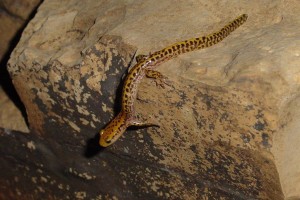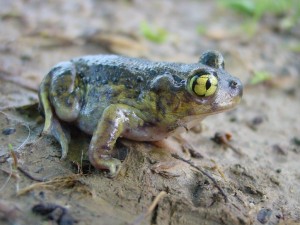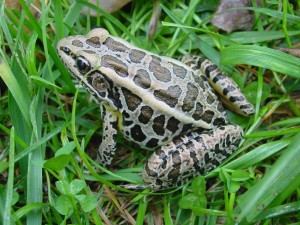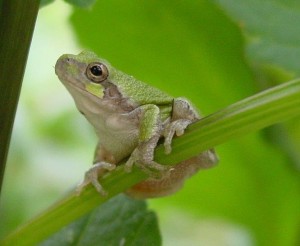Amazing Amphibians
Article and photos by Bob Weck, Southwestern Illinois College and Clifftop
Illinois is home to 41 species of native amphibians, 21 species of frogs and toads and 20 salamander species. You might be surprised to learn that more than 60% of these amphibian types can be found locally, in a few mile wide swath of land on either side of the bluffs that stretch from Dupo in the north to Prairie Du Rocher in the south. The key to such rich diversity is the multitude of habitats included in the “bluff corridor.” The bluffs themselves provide a myriad of hidey-holes and slabs of lose rock for amphibians to shelter. Capping the bluffs are hill prairies and woodland ecosystems that provide abundant invertebrates, which are food for hungry amphibians. And then there is the water!
The term amphibian is derived from two Greek terms, amphi (meaning ‘both’) and bios (meaning ‘life’), a reference to the fact that most species in the group have a larval stage in the water and an adult stage that live on land. If you head east away from the bluffs you quickly encounter a karst terrain peppered with circular sinkhole ponds: perfect breeding habitat for many frogs, toads and salamanders. Flowing under the sinkhole plain are cave streams that provide cool refuge in the summer and overwintering sites for some species. To the west, the floodplain of the Mississippi River terminates at the base of the bluffs. Marshes and temporary wetlands of the floodplain are some of the best places in the area to find amphibians.
Of the two local amphibian groups, frogs and toads are much more familiar to most of us (how many of you have ever actually seen a live salamander in the wild?). In fact, 88% of all amphibian species on Earth are some type of frog or toad. Frogs have an impressive suite of adaptations that makes them so successful. Powerful hind limbs allow frogs to travel relatively long distances while feeding and searching for breeding sites. Modifications to toes and feet allow some to climb trees, some to burrow in the dirt, and allow others to be efficient swimmers.
Frog and toad reproduction is a noisy affair. Males of each species produce a unique mating call. Many species are “explosive breeders” with nearly all individuals breeding in a narrow time frame, triggered by warming spring temperatures and rainfall. Loud choruses of calling males form at breeding sites. Females from surrounding areas are attracted to the chorus and can even make their choice of which male to seek based on his call within the chorus. Fertilized eggs hatch into the aquatic larval stage commonly called a tadpole or pollywog.
Tadpoles are herbivores. They use rows of hard ridges on their lips to scrape algae and submerged plant material into their mouth. As rough as puberty seems to a human teenager, imagine the changes the tadpole undergoes in its metamorphosis to a frog. Sprouting arms and legs, supported by brand new nerves, muscles, and bones is impressive. But, the really amazing changes are happening in the tadpole’s digestive system. The entire intestinal system transitions from a very long coiled tube adapted to digesting plants to a shortened carnivore system since adult frogs and toads eat insects and other invertebrate animals. The entire metamorphosis plays out in a matter of days or a few weeks.
Salamanders are quiet and secretive amphibians that venture out at night to feed on invertebrates. Their thin skin limits salamanders to relatively cool and moist environments. Salamanders do most of their respiration across the skin and some species have abandoned lungs all together. Unlike frogs, male salamanders use chemical signals and courtship behaviors to attract females within a breeding pool or stream. Salamander eggs hatch into a larval stage that is essentially a small gilled version of the adult. Therefore, the transformation to terrestrial adult is much less dramatic in salamander larvae than in tadpoles.
Globally, more than 1/3 of all amphibian species are in danger of extinction. The reasons for amphibian declines are many, and include habitat loss, pollution and the spread of pathogenic skin fungi. If you are lucky enough to own or manage property that supports populations of frogs and salamanders, consider amphibian-friendly management choices (see http://www.clifftopalliance.org/amphibians-in-sinkhole-ponds-best-management-practices/ for examples).
Bob Weck is Professor of Biology, at SWIC and is a member of Clifftop’s Board of Directors.
Please join Clifftop on our Frog Frolic Field Trip to see what amphibians we can discover and learn more about. The field trip will be at the Paul Wightman Subterranean Nature Preserve, Fults, IL on Saturday, May 13 from 11 to 1 PM. The program is free and open to the public. Registrations are required by May 10 and may be made by email to cliffmbr@htc.net or by calling 618-935-2542.
CLIFFTOP, a local nonprofit organization, is focused on preserving and protecting area bluff lands.
A version of this article appeared in the 5 May 2017 edition of the Monroe County Independent.
© 2017 all content rights reserved Clifftop NFP
Comments are currently closed.




